The article delves into the breakup of Yugoslavia and the devastating war in Mostar, focusing on the experiences of its residents during the siege.
Mostar, a city in Bosnia and Herzegovina, endured over three years of intense conflict during the Bosnian War of 1992-1995.
Today, visitors can gain a deeper understanding of this dark chapter in history through a guided tour, seeing the stories and locations that showcase the resilience and strength of the people of Mostar.
Good To Know

- Mostar was sieged for over three years during the Bosnian War, leaving the city devastated.
- The guided tour of Mostar offers visitors the opportunity to learn about the war and its impact on the city.
- The tour provides a deeper understanding of the difficult stories and experiences of the people of Mostar during the war.
- Participants highly recommend the tour, praising the informative and passionate tour guide and the valuable insights gained from the experience.
The Break-up of Yugoslavia: Historical Context
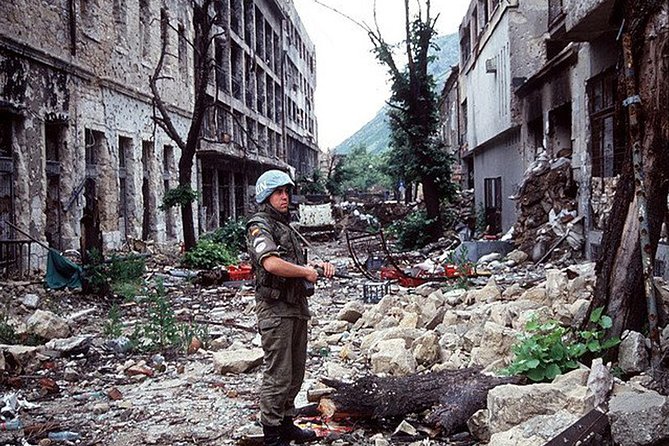
Why did the break-up of Yugoslavia lead to the Bosnian War and the siege of Mostar?
The break-up of Yugoslavia in the early 1990s was a result of rising nationalism and ethnic tensions within the country. As the different republics sought independence, conflicts arose between different ethnic groups, particularly in Bosnia and Herzegovina.
The Bosnian War, which lasted from 1992 to 1995, saw intense fighting between Bosniaks, Croats, and Serbs. Mostar, a city in Bosnia and Herzegovina, became a major battleground during the war, with ethnic divisions and rivalries fueling the violence.
The siege of Mostar, lasting over three years, resulted in widespread destruction and loss of life.
The break-up of Yugoslavia, combined with the rise of nationalism and ethnic tensions, ultimately led to the Bosnian War and the devastating siege of Mostar.
Find more activities and experiences we've covered in Mostar.
The Rise of Nationalism and Ethnic Tensions
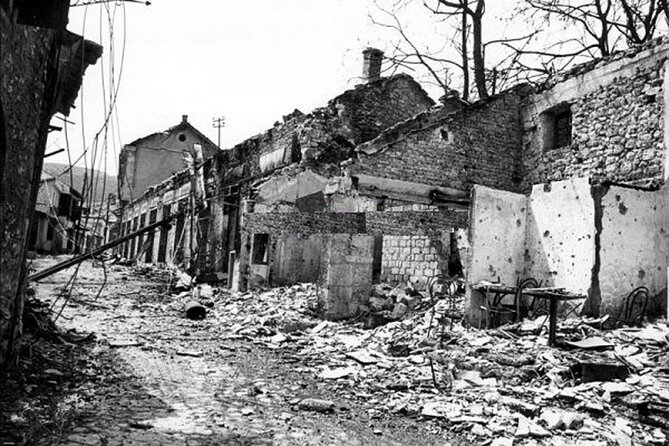
Nationalism and ethnic tensions played a significant role in the escalation of conflicts during the break-up of Yugoslavia and the Bosnian War. As the country began to dissolve in the early 1990s, nationalist sentiments started to rise among different ethnic groups.
This led to increased tensions and hostilities between the Serbs, Croats, and Bosniaks, who each sought to establish their own independent states. Nationalist leaders fueled these tensions by promoting exclusivist ideologies and manipulating historical grievances.
Ethnic tensions were further exacerbated by the use of propaganda, hate speech, and violence, which deepened divisions and created an environment conducive to the outbreak of war.
The rise of nationalism and ethnic tensions ultimately contributed to the brutal and protracted conflict that engulfed Yugoslavia, including the city of Mostar, during this turbulent period.
Mostar: A City Divided
While the war raged on, Mostar became a city divided by ethnic and religious lines. The conflict between the Bosniaks and Croats led to the division of the city, with the Bosniak-controlled east side and the Croat-controlled west side. This division was further reinforced by physical barriers such as barricades and sniper positions, creating a stark separation between the two communities. The destruction caused by the war resulted in a fractured city, with each side struggling to rebuild and recover. The scars of the conflict were not only physical but also deeply ingrained in the social fabric of Mostar. It would take years of efforts and reconciliation for the city to regain its unity and move towards post-war recovery.
| Bosniak-controlled East Side | Croat-controlled West Side |
|---|---|
| Severely damaged buildings | Destroyed infrastructure |
| Scarce resources | Limited access to services |
| High unemployment rates | Economic stagnation |
| Strained inter-ethnic relations | Tensions and mistrust |
The Siege of Mostar Begins
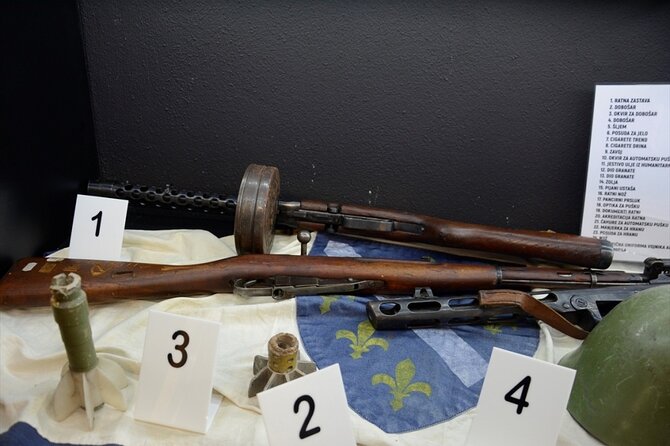
As the conflict escalated, the Bosnian Serb forces launched the siege of Mostar, cutting off essential supplies and subjecting the city to relentless bombardment. The people of Mostar were forced to endure daily hardships as they struggled to find basic necessities like food, water, and medicine.
The city’s infrastructure was severely damaged, with homes, schools, and hospitals being targeted during the bombings. Despite the dire circumstances, the residents of Mostar valiantly fought to preserve their cultural heritage. They worked tirelessly to protect and restore important historical sites such as the iconic Old Bridge, which held immense cultural and symbolic significance for the city.
Despite the destruction and suffering, the people of Mostar remained resilient in their determination to preserve their cultural identity throughout the siege.
Life in the Crossfire: Daily Struggles and Survival
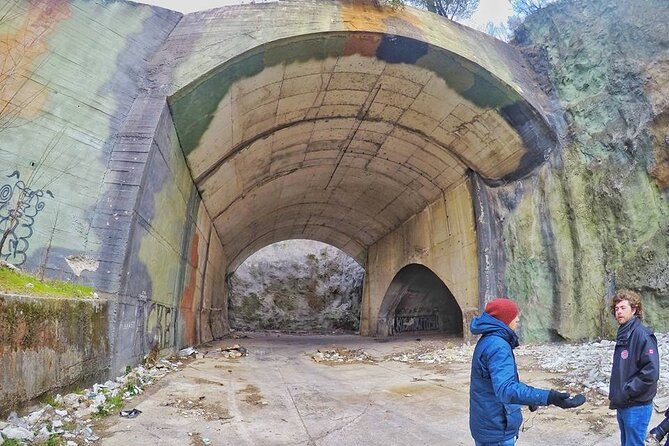
The residents of Mostar faced constant danger and uncertainty, but they persevered in their fight for survival. Life in the crossfire was marked by daily struggles and the need for survival strategies. The table below highlights some of the challenges they faced and the strategies they employed:
| Daily Struggles | Survival Strategies | Impact |
|---|---|---|
| Shortage of food, water, and basic supplies | Rationing and resource sharing among neighbors | Ensured basic needs were met |
| Fear of sniper fire and shelling | Seeking shelter in basements and underground tunnels | Minimized exposure to danger |
| Lack of medical care and access to medications | Utilizing traditional remedies and makeshift clinics | Addressed health issues as best as possible |
Despite the difficult circumstances, the residents of Mostar demonstrated resilience and ingenuity in their daily struggles, employing various survival strategies to navigate through the crossfire. These strategies helped them mitigate risks and ensure their basic needs were met amidst the chaos of war.
- Break-up of Yugoslavia & The War in Mostar: Life Under Siege
- Discover Herzegovina Day Tour From Mostar: Kravice Waterfalls, Blagaj, PočItelj
- Herzegovina Day Tour From Mostar: Blagaj, Pocitej, Kravice Falls (Join Us! :D)
- Mostar and Kravice Waterfalls Full-Day Tour From Split
- Mostar and Kravice Waterfalls Tour From Dubrovnik
- Mostar & Kravica Waterfall: Small Group Tour From Dubrovnik
Destruction and Devastation: The Impact on Infrastructure
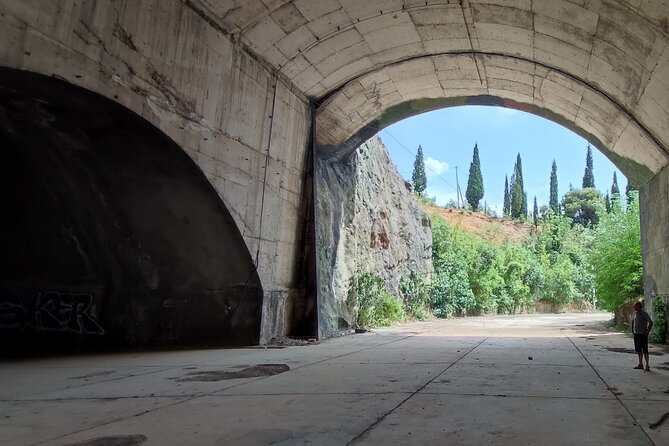
With buildings reduced to rubble and roads left impassable, the war in Mostar wreaked havoc on the city’s infrastructure. The impact on infrastructure was devastating, leaving the city in ruins and causing immense challenges for its residents. Here are three key points to understand the gravity of the situation and the subsequent rebuilding efforts:
Destruction of Buildings: Many buildings in Mostar were destroyed or severely damaged during the war. Bombs and artillery fire reduced homes, businesses, and public buildings to rubble, leaving behind a landscape of destruction.
Impassable Roads: The war also rendered the city’s roads impassable. Craters from explosions, debris from destroyed buildings, and barricades made it extremely difficult for people to navigate the city, hindering transportation and access to essential services.
Rebuilding Efforts: Since the war, significant efforts have been made to rebuild the infrastructure in Mostar. Reconstruction projects have focused on restoring damaged buildings, clearing roadblocks, and improving transportation networks to restore normalcy and facilitate the city’s recovery.
The impact of the war on Mostar’s infrastructure was immense, but the rebuilding efforts have been instrumental in restoring the city’s functionality and providing hope for a better future.
Ethnic Cleansing and Massacres: The Dark Side of the War
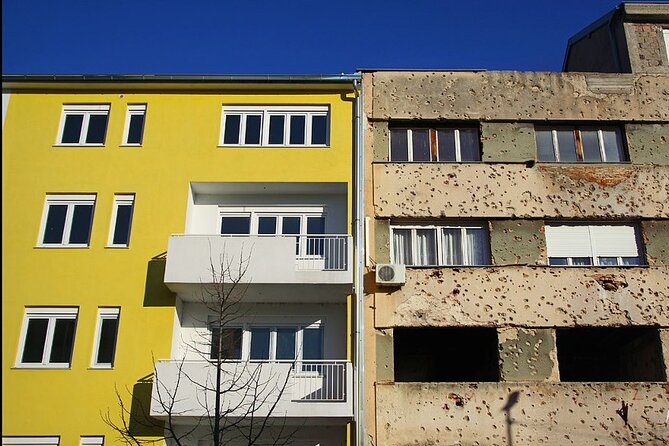
During the war in Mostar, countless innocent civilians fell victim to ethnic cleansing and massacres, perpetuating the dark side of the conflict. Ethnic cleansing refers to the deliberate removal or extermination of a particular ethnic group from a specific area. In Mostar, this involved the targeting and expulsion of Bosniak Muslims by Bosnian Croats and vice versa. The objective was to create ethnically homogeneous territories and eliminate any perceived threats from the opposing group.
Massacres, on the other hand, were brutal acts of violence that resulted in the killing of large numbers of people, often targeting civilians. These atrocities were committed by various factions involved in the war, with both sides bearing responsibility.
The massacres and ethnic cleansing in Mostar left a lasting impact on the city, traumatizing its residents and perpetuating deep-seated divisions between different ethnic groups.
The Role of International Intervention and Peacekeeping
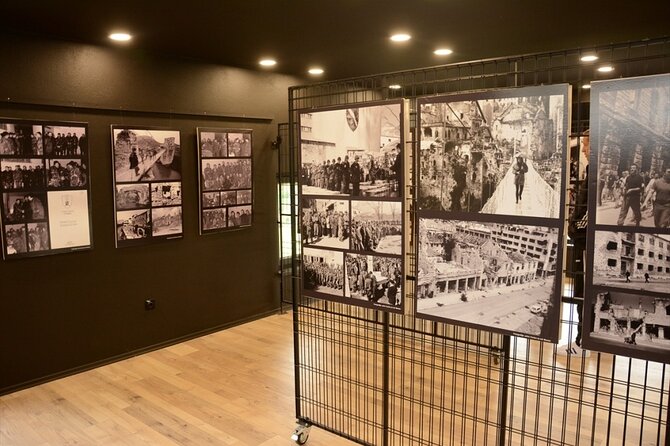
While international intervention and peacekeeping efforts played a crucial role in the war in Mostar, their effectiveness in mitigating the conflict’s impact on the city and its residents was limited.
Role of international organizations:
- Various international organizations, such as the United Nations (UN), European Union (EU), and NATO, were involved in peacekeeping efforts in Mostar.
- These organizations aimed to facilitate negotiations, provide humanitarian aid, and monitor ceasefires.
- The presence of international organizations helped bring attention to the conflict and put pressure on warring parties to seek a resolution.
Effectiveness of peacekeeping efforts:
- Despite the presence of international organizations, the conflict in Mostar continued for several years, resulting in widespread destruction and loss of life.
- Peacekeeping efforts faced challenges due to the complex ethnic and political dynamics in the region.
- Limited resources, inadequate mandates, and difficulties in enforcing peace agreements also hindered the effectiveness of these efforts.
Rebuilding Mostar: Challenges and Progress
One of the major challenges faced in rebuilding Mostar after the war was the extensive damage to infrastructure. The city had suffered significant destruction during the Bosnian War, leaving buildings, roads, bridges, and utilities in ruins. This posed a significant obstacle to the process of rebuilding and restoring normalcy in the city.
However, despite these challenges, Mostar has made remarkable progress in its reconstruction efforts. Post-war progress can be seen in the restoration of iconic landmarks such as the Stari Most (Old Bridge), which was destroyed during the war but rebuilt in 2004. Plus, efforts have been made to rebuild schools, hospitals, and other essential facilities to improve the quality of life for the residents.
Despite the ongoing challenges, Mostar continues to make strides in its journey towards recovery and rebuilding.
Healing Wounds: Reconciliation and the Road to Peace
Despite the deep divisions that existed, the people of Mostar worked towards healing wounds and achieving reconciliation in the aftermath of the war. The following are some of the reconciliation efforts and peacebuilding initiatives undertaken in Mostar:
Interethnic Dialogue: Various initiatives fostered dialogue and communication between the different ethnic groups in Mostar. These platforms provided an opportunity for individuals to express their grievances, share their experiences, and understand each other’s perspectives.
Community Projects: Numerous community projects were implemented to bring people from different backgrounds together. These projects aimed to create a sense of unity and promote cooperation among the residents of Mostar. Examples include joint cultural events, sports tournaments, and collaborative art projects.
Education and Awareness: Efforts were made to educate the younger generation about the importance of reconciliation and peaceful coexistence. Schools introduced programs and activities that focused on promoting tolerance, understanding, and respect for diversity. Plus, awareness campaigns were conducted to inform the public about the consequences of division and the benefits of unity.
These reconciliation efforts and peacebuilding initiatives have played a crucial role in rebuilding trust and fostering a sense of harmony among the people of Mostar.
Lessons From Mostar: Remembering the Past, Shaping the Future
Many visitors to Mostar gain valuable insights into the past and future by reflecting on the lessons learned from the city’s history. Remembering the past is crucial in shaping the future, and Mostar offers important lessons in resilience, survival, and hope. During the war, the people of Mostar endured unimaginable hardships, yet they never lost their spirit and determination to rebuild their city. Their stories of survival and hope inspire others to overcome adversity and work towards a better future. The table below highlights some key lessons from Mostar’s history:
| Lessons from Mostar |
|---|
| Resilience |
| Survival |
| Hope |
Through remembering the past, Mostar serves as a reminder that even in the darkest times, there is always a glimmer of hope and the possibility for a brighter future. The city’s history stands as a testament to the strength of the human spirit and the power of unity in the face of adversity. By learning from Mostar’s past, we can shape a future that is rooted in compassion, understanding, and peace.
Common Questions
The tour guide shares personal anecdotes and stories during the tour, providing visitors with a deeper understanding of the war’s impact on Mostar. These firsthand experiences offer a unique and emotional perspective on the city’s history.
Can Visitors See Photos of the Bunkers, Ruins, and Other Significant Sites Visited During the Tour?
Yes, visitors can see photos of the bunkers, ruins, and other significant sites visited during the tour. These photos provide a visual representation of the historical sites and help visitors understand the impact of the war on Mostar.
What Is the Emotional Impact of the Tour, and How Does the Guide Contribute to It?
The emotional impact of the tour is significant, as visitors are moved by the tragic stories shared by the guide. The guide plays a crucial role in creating this impact by passionately and impartially sharing personal experiences and historical information.
Does the Tour Provide Insights Into the Complex Situation of Mostar During the War?
Yes, the tour provides insights into the complex situation of Mostar during the war. Visitors learn about the historical context and the impact it had on daily life through personal stories and visits to significant sites.
How Does the Tour Contribute to Participants’ Understanding and Appreciation of the Resilience of the People of Mostar?
The tour provides participants with a deeper understanding and appreciation of the resilience of the people of Mostar. Through personal stories, visits to significant sites, and insights into the city’s history, the tour highlights the strength and determination of the people in the face of adversity.
The Sum Up
To sum it up, the break-up of Yugoslavia and the war in Mostar left a lasting impact on the city and its residents.
Through guided tours and firsthand accounts, visitors can gain a deeper understanding of the harrowing experiences and resilience of the people of Mostar.
The city’s journey towards reconciliation and peace serves as a powerful reminder of the importance of remembering the past and shaping a better future.
More Tour Reviews in Mostar
- Buggy Safari from Mostar to 1600m with Traditional Food
- Burek Masterclass: Roll, Bake, Eat
- Day trip to Mostar old bridge and Krawice waterfalls
- Dubrovnik: Kravica & Mostar Day Trip | All Tickets Included
- Dubrovnik: Mostar, Blagaj & Kravice Waterfalls Tour
- Dubrovnik to Mostar Transfer with Kravice, Blagaj, Pocitelj
Looking for something different? Other Mostar activities we've written about
- Buggy Safari from Mostar to 1600m with Traditional Food
- Burek Masterclass: Roll, Bake, Eat
- Day trip to Mostar old bridge and Krawice waterfalls
- Dubrovnik: Kravica & Mostar Day Trip | All Tickets Included
- Dubrovnik: Mostar, Blagaj & Kravice Waterfalls Tour
- Dubrovnik to Mostar Transfer with Kravice, Blagaj, Pocitelj
- From Dubrovnik: Private Day Trip Mostar and Kravica falls
- From Mostar: Blagaj, Poitelj & Kravice Waterfalls Day Tour
- From Mostar: Day Tour to Blagaj, Pocitelj, and Kravice
- From Mostar: Half-Day Trip to the Kravica Waterfall
- From Mostar: Kravice Waterfalls, Pocitelj & Blagaj Day Trip
- From Mostar: Kravice Waterfalls, Blagaj, & Poitelj
